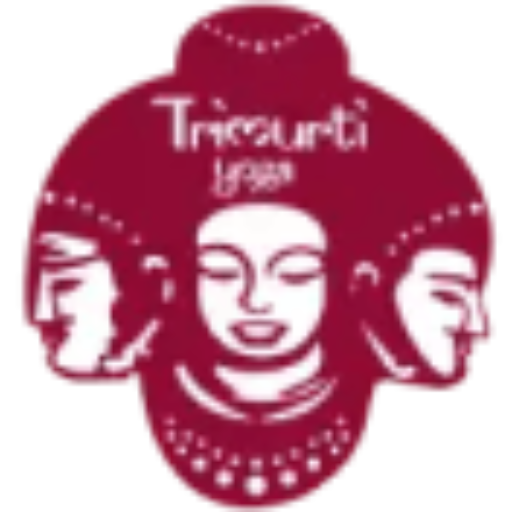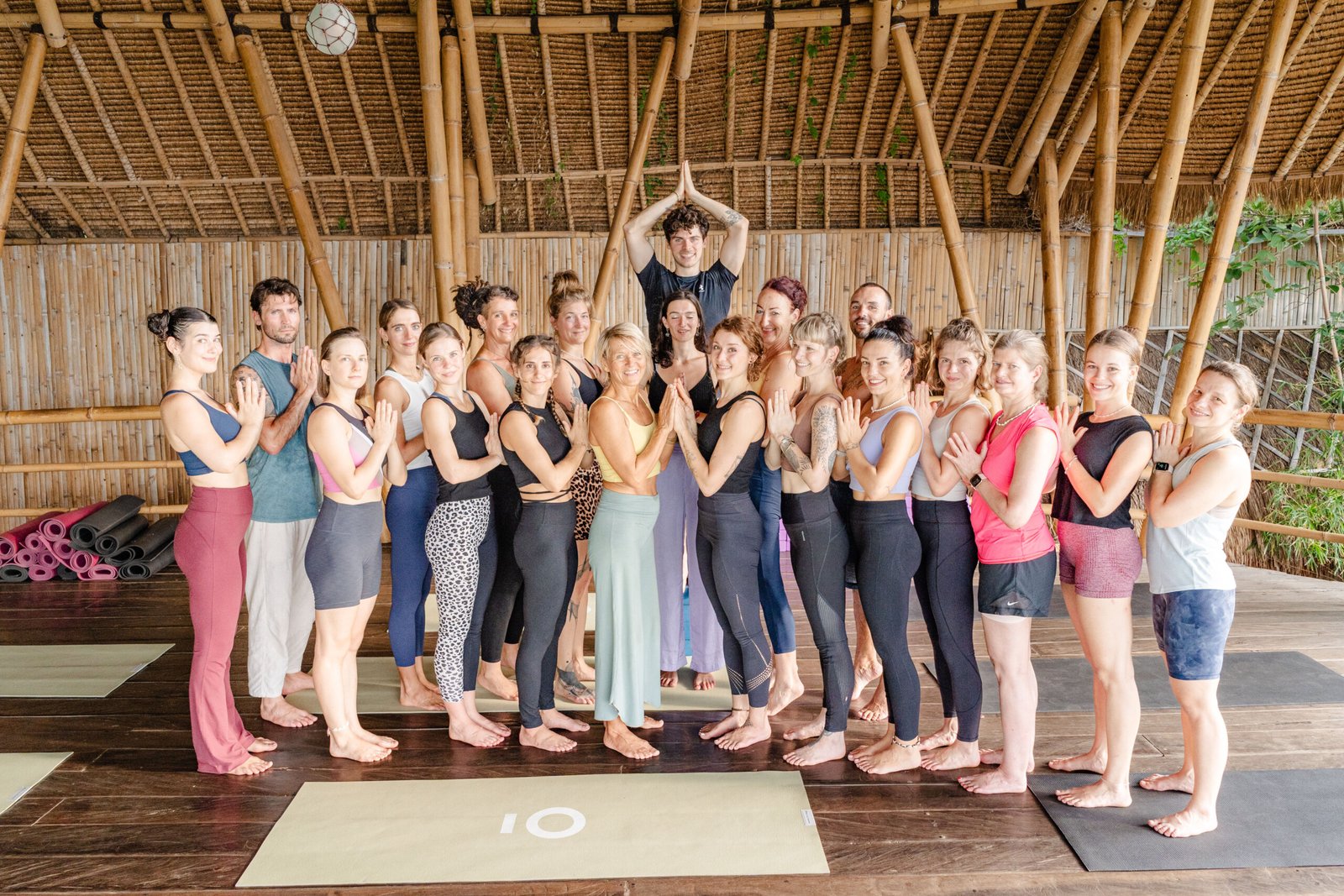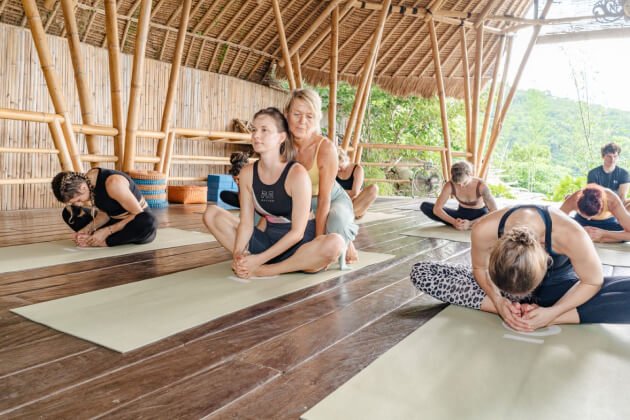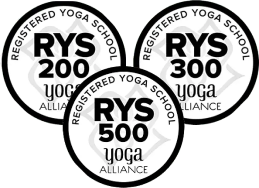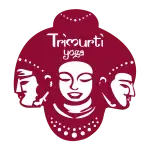Start a transformative adventure in Bali, the Island of Gods, with Trimurti Yoga Bali. Our Advanced Yoga Teacher Training In Bali training program is an intensive 26-day course that focuses on vinyasa flow, yin yoga, and meditation.
Along with providing you with the necessary tools to advance as a yoga teacher and expand your understanding of asana and practice, it will help you learn yoga more profoundly.
We understand that you should have finished a 200-hour yoga teacher training program in any style with a yoga alliance-certified school before enrolling in this course. You can register with Yoga Alliance as a 500-Hour Registered Yoga Teacher (RYT) by completing this course in addition to your prior one.
This course’s main goal is to develop your understanding of instructing vinyasa flow yoga classes in addition to yin yoga and meditation classes.
The majority of your time will be dedicated to learning the sequences for both yin yoga and vinyasa flow classes, as well as developing a deeper knowledge of the various meditation techniques and how to use them to improve self-awareness.
In addition to helping you develop your practice, this course will educate you on how to provide a secure environment in which your students can perform proper asana. Along with learning about anatomy, teaching strategies, yogic philosophy, and the art of sequencing, you will also acquire an extensive understanding of alignment and adjustment.
We at Trimurti Yoga Bali invite you to enroll in this course and bring your lessons to further develop as a yoga teacher by learning, practicing, and teaching with others. As we learn new things every day, our highly qualified staff of yoga instructors will personally hold your hand to make this journey exciting and enjoyable.
Table of Contents
ToggleYou are Eligible to do the Advanced Yoga Teacher Training in Bali
- If you are a yoga instructor who is prepared to advance the level of your instruction.
- If you’re looking to expand on your prior knowledge and gain a better understanding of anatomy, yogic philosophy, and adjustments and alignments in a supportive environment that inspires you to challenge yourself as a yoga instructor.
- If you want to learn more about meditation and its different methods in-depth.
- If you want to know more about practical modifications for teachers.
- If you want more hours of teaching experience, you’ll be spending many hours in the yoga teacher community.
- If you’d like to know more about the order of the classes and yin yoga.
- If you want to actively participate in the large yoga instructor community.
- If you want to increase the scope of your yoga teaching certification.
Requirements Before Taking This Course:
- You’ve finished a 200-hour yoga teacher training program in any style from any accredited institution, such as Trimruti Yoga, which is approved by Yoga Alliance. You will receive a certificate at the end of this course designating you as a 500-Hour RYT.
- You finished a 200-hour yoga teacher training program, regardless of style, from a school that is not listed with Yoga Alliance. In that instance, you will receive a 300-hour yoga teacher training certificate from us, but you won’t be able to register with Yoga Alliance to become a 500-hour RYT.
- Despite not having taken any previous courses, you have a strong practice and want to develop in your yoga teaching career. You will receive a 300-hour Yoga Teacher Training certificate from us, but you won’t be allowed to sign up for Yoga Alliance classes.
The 300-hour Yoga Teacher Training Course Curriculum
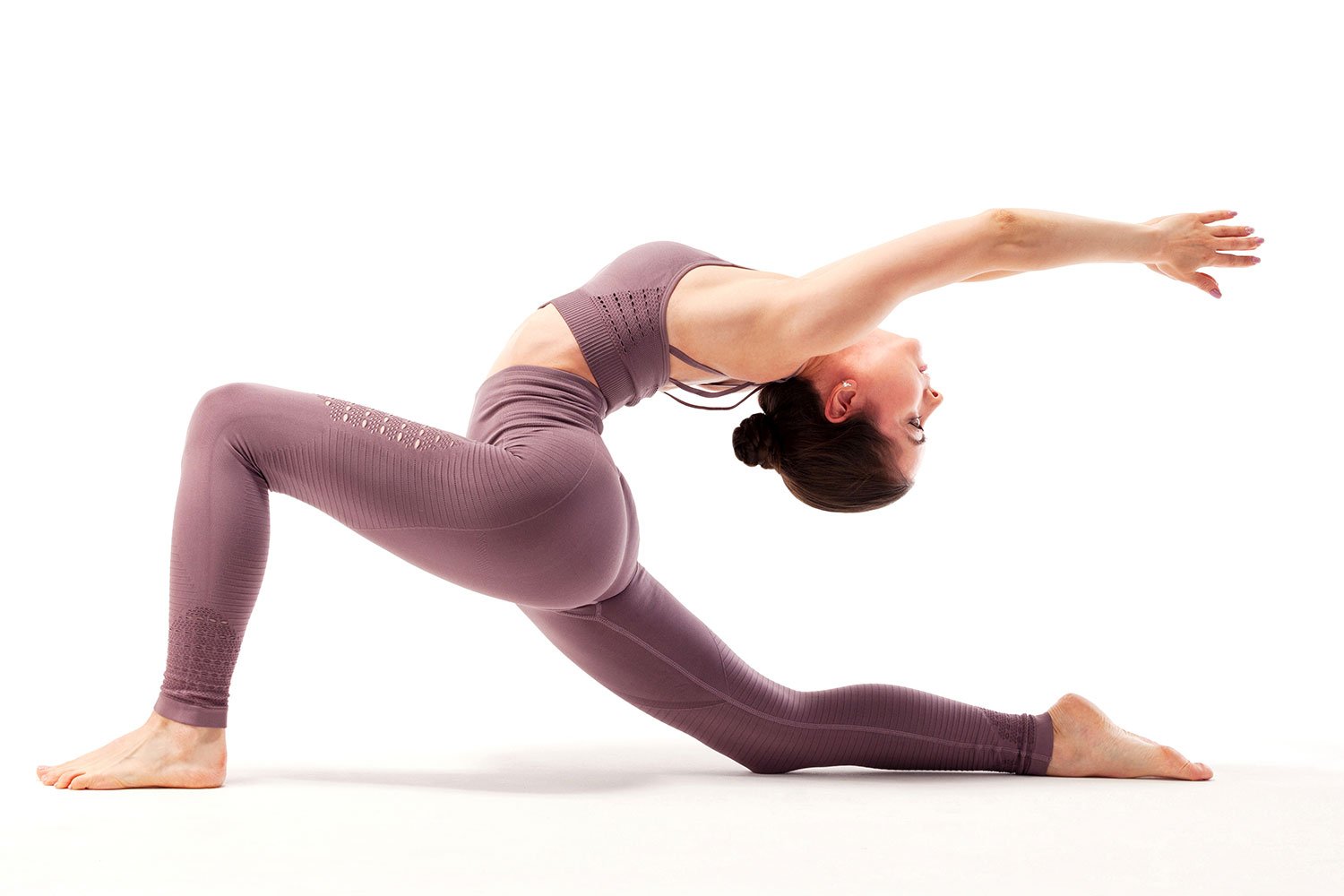
Module 1: Vinyasa Flow
One of the most well-liked modern yoga practices is a vinyasa flow, which is built on a quicker, more dynamic pace. There are many different ways to practice vinyasa. Some include the tough Ashtanga Primary Series, Vinyasa Krama Yoga programs, and contemporary flows that incorporate dance, martial arts, and fitness. You can experience a wide range of Vinyasa flow styles at Trimurti Yoga, from the basic Ashtanga to the restorative Five Elements flows to its innovative and extremely contemporary forms.
Syllabus of Second Module:
- Asana: yoga poses and classes based on Ashtanga and Vinyasa Krama.
- Techniques for alignment and adjustment.
- Sequencing – basic and advanced sequencing techniques.
- Cueing – types of cueing and effective cueing strategies for dynamic styles of practice.
- Philosophy – Patanjali’s Yoga Sutras with a contemporary approach.
- Yoga Science – basics of Ayurveda and 5 Elements.
- Functional Anatomy – asana-based anatomy approach, biomechanics of the body, understanding of the nervous system.
- Mentoring and consistent instruction in a supportive setting.
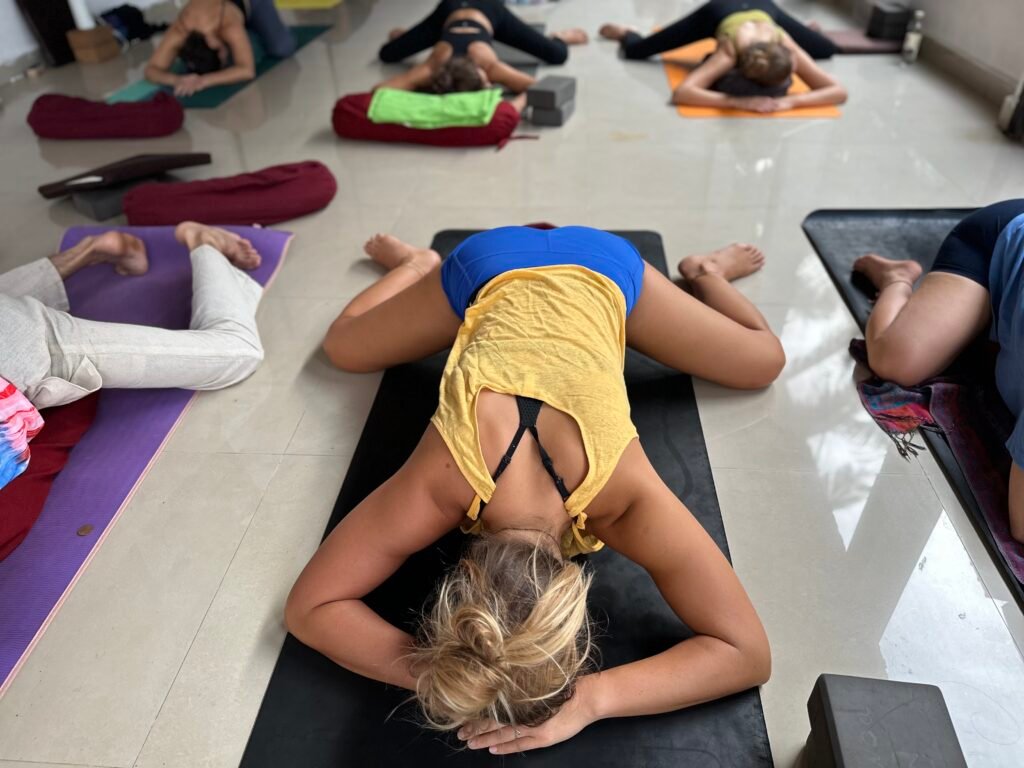
Module 2: Yin Yoga
Over the last few years, yin yoga has grown to be one of the most widely practiced yoga styles worldwide. We feel physically and mentally drained by our present “Yang” lifestyle, which involves multitasking, frequent movement, and the push for greater accomplishment. We can only achieve balance by including additional “Yin” components in our work. It will help us in relaxing our body and mind and calm down our parasympathetic nervous system.
Yin yoga is a meditative, slow-paced form of yoga in which we hold different poses for prolonged periods of time—typically five minutes or longer—so that our bodies can experience steady pressure on each tissue. The primary goal of practicing yin yoga is to maximize muscular relaxation. Yin yoga aligns with our body’s acupressure points (earth, water, fire, air, and space) and is entirely based on TCM (Traditional Chinese Medicine).
Syllabus of First Module:
- The application of yin yoga to traditional Chinese medicine (TCM).
- The Yin and Yang Theory.
- TCM based five-element theory.
- The location and functioning of the main meridians in human bodies.
- Organs of Yin and Yang and their roles.
- Yin poses that support the organs, meridian points, and five elements.
- Anatomy of the spine – how to practice Yin Yoga safely for the spine.
- Functional anatomy – the study of the shoulders, torso, back, and upper limbs.
- “Asana Clinic”: personalized adjustments to Yin poses for each participant.
- Yin yoga teaching methodology, including yoga props, sequencing, and intersections.
- Philosophy of yoga.
- Practicum in teaching.
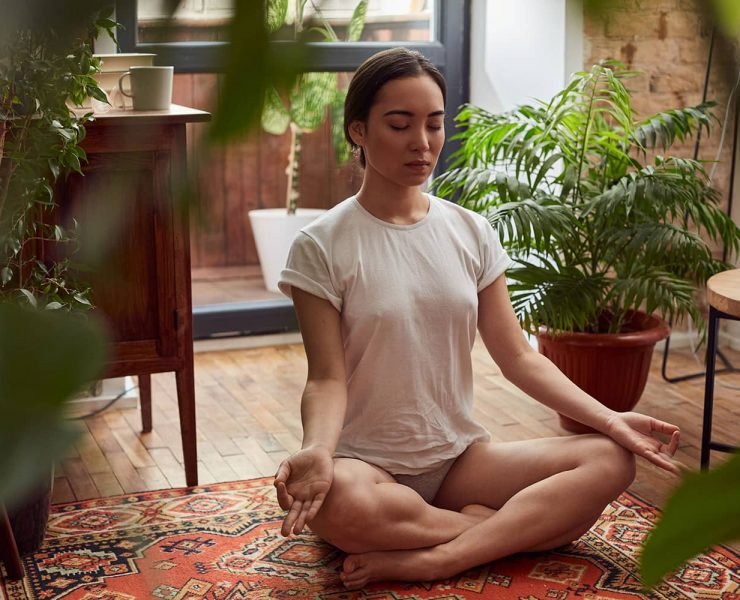
Module 3: Meditation
PRANAYAMA A typical term for yogic meditation is pranayama. Translations typically read “breath control.” “Prana” signifies life essence and “yama” implies control in Sanskrit. Another name for it is “life source.” While most Buddhist meditations concentrate on the observation of the breath in a passive manner, yogic meditations, such as pranayama, primarily work on the active control of the breath, or “becoming the master of breath.” You can use a variety of pranayama meditation techniques in your day-to-day activities.
YOGA NIDRA “Yoga” refers to mindfulness, and “Nidra” to sleep. Yoga Nidra is the practice of mindful sleep. It is an extremely methodical and scientific approach. It addresses the subconscious. removes undesirable inclinations. plants new characteristics and shapes the entire person. The practice of Yoga Nidra leads to a deep state of consciousness known as Prajna.
Everyone naturally engages in meditation. A youngster plays while meditating. A scientist meditates while a dancer performs and a vocalist sings. While completing a test, every student writes with a meditative mind. Think back to your time in school or college. On the day of the exam, if you studied thoroughly, you should be able to respond to any queries. You entered the examining room. You forget about the exam the following day. Once you receive the question paper, you will only think about the question on the paper. When responding to a specific question, you consider it and don’t consider unanswered ones. You don’t consider the question to be answered or the one that has already been answered. This state of mind is called the meditative mind.
Syllabus of Third Module:
- What meditation is defined as? The function of asanas and pranayama is to prepare the body and mind.
- What Pratyahara means. Pratyahara’s internal and external techniques serve as an introduction to meditation.
- The meaning of Dharana. Dharana is a set of internal and external exercises done before meditation.
- Various forms of meditation include those that are focused on the width and chakras, mantras, sound, and quiet, among others.
- Pranayama: Sheetali & Sheetkari (to chill the body); Khapala Nhati (to warm the body); Bhramari (to calm the mind). Alternate nostril breathing.
- Yoga Nidra: Its definition, application, and range of use.
- The structure of Yoga Nidra practice. a thorough breakdown of every step. Yoga Nidra’s Pratyahara, Dharana, and Dhyana.
- Organizing a Yoda Nidra session and choosing the Yoga Nidra theme.
Daily Schedule
- 6:30-9:00 | SADHANA & MORNING PRACTICE
- 9:00-10:00 | BREAKFAST
- 10:00-11:30 | YOGA PHILOSOPHY & EDUCATION
- 11:45-1:00 | POSTURE LAB
- 1:00-2:30 | LUNCH
- 2:30-4:00 | ANATOMY
- 4:15-5:45 | EVENING REFLECTION (YIN, KUNDALINI…)
- 6:00-7:00 | MEDITATION

